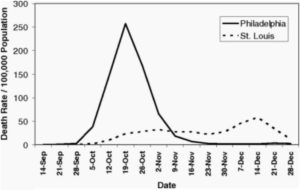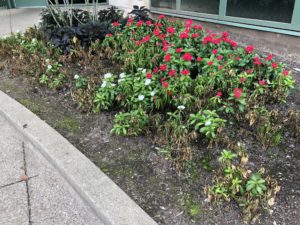Plant pathology is the study of plant diseases. In my career, I’ve studied or witnessed the plant disease epidemics of chestnut blight, Dutch elm disease, sudden oak death, soybean rust, and many more. I am not comparing these to the current pandemic of Covid-19. It doesn’t compare. Please understand this is just an opportunity for education.
Epidemiology is the study of disease. It is a study by public health experts, and it is a study done by plant pathologists. There are some similarities and obviously, some very significant differences.
Quarantines actually began in the fourteenth century in response to the Black Death (plague, caused by the bacterium, Yersinia pestis) and continue to be used to this day because they are effective. Quarantines and social distancing during the 1918 ‘Spanish Flu’ pandemic were implemented differently between Philadelphia and St. Louis, with very different outcomes (Fig. 1). A critical lesson from data modeling and the historical record is that quarantine and social distancing work best when they are implemented early, and when they are maintained.

Figure 1. Philadelphia and St. Louis responded differently to the Spanish Flu pandemic of 1918, with very different outcomes.
Although plant quarantine can mean the legal enforcement to prevent pathogens and pests from establishment in new areas, it is also an IPM tactic that can be used to prevent disease introduction and establishment in a nursery, greenhouse or landscape. For plants, quarantines often begin in the greenhouse and nursery long before plants reach the landscape. Ideally, new shipments should be isolated from any already present stock, to prevent the introduction of disease to the entire greenhouse or nursery. In this instance, the goal of this type of quarantine is to prevent the introduction of asymptomatic but diseased plants. Many plant diseases, just like human diseases, have an incubation period. For plants, this period can be a few days to several weeks.
One of the most challenging aspects of Covid-19 is that many infected people are asymptomatic or have mild symptoms. These people can spread the virus to others for days before they develop symptoms or realize they are infected. These asymptomatic people can easily spread disease to people who are older, or have pre-existing health conditions, with the results being catastrophic. Quarantine works directly to prevent the unintentional spread of any disease.
We see this same phenomenon play out in the plant world: Many viruses, bacteria, root rots, foliar nematodes, and downy mildews are introduced via asymptomatic plant material. Sudden oak death (SOD), caused by Phytophthora ramorum, has been spread through our industries by infection on shrubs like rhododendron, pieris, azalea, and camellia. These plants exhibit just minor leaf spots and blights that are often overlooked, the same way we overlook a sniffle, cough or sneeze. Unfortunately, the cause of SOD (also called Ramorum canker and blight) produces millions of spores on the shrub hosts, that can infect and kill other shrubs like viburnum, in addition to oaks, larch and many other types of trees. Nurseries focus on the ‘filthy five’, rhododendron, azalea, camellia, pieris, and kalmia, which can spread SOD, and often quarantine these to prevent the introduction to SOD to the nursery or landscape.
Social Distancing

Figure 2. Hot, wet, humid conditions drove this Phytophthora epidemic of vinca. Note the ‘resistance’ of the ornamental pepper.
That 6-ft social distance is simply to keep the Covid-19 virus from coming in contact with another person. The simple act of talking produces aerosols of saliva, and, if the person is infected, the disease is spread. Maintaining at least a 6-ft distance to prevent the spread is one way to slow the spread of the disease. Now, obviously, plants are not social creatures, but crowding plants can create conditions that are conducive for plant disease outbreaks. Tight spacing reduces airflow between plants and increases the relative humidity in the canopy. This increases leaf wetness and prevents drying—creating a conducive environment for many plant pathogens (Fig. 2). Tight plant spacing also prevents good coverage with pesticides when plants are blocking each other from contact with the pesticide spray. Simply spacing plants their recommended distance permits airflow that can reduce or eliminate the need for pesticides, while improving application efficacy when pesticides must be used.
Handwashing
One of the simplest things we can do at this time is wash our hands with soap and warm water for 20 seconds if we handle something that may have been contacted by someone else, if you touch your face, if we sneeze or cough into our hands, and of course, after using the restroom. Plants have no such need or ability, but our ability to wash our hands reduces the spread of many plant viruses, including tobacco mosaic virus. Disinfestants like Lysol or bleach kill microbes when used to surface sterilize counters, handles, and common areas. In the greenhouse or nursery help reduce overwintering inoculum of many plant pathogens, including Rhizoctonia, Pythium, algae, bacterial and viral plant pathogens. Common greenhouse and nursery disinfestants include bleach, 70% alcohol, hydrogen peroxide (Zerotol), peroxyacetic acide (Oxidate, Sanidate), potassium peroxymonosulfate (Virkon Greenhouse), and the quaternary ammonium chlorides or Q-salts (e.g., Green-Shield, KleenGrow ,Physan 20).
Risk Communication versus Infodemic
How risk is communicated is perhaps one of the most important factors to control any disease outbreak. As people, we have the option to behave in a way to protect ourselves, our friends, our families, and each other to delay, avoid or prevent the epidemic escalation of Covid-19. Right now, focus on the people in your life—and take some time to enjoy plants. They provide a sense of peacefulness and beauty that we can all use right now. Most of all, let’s all practice social distancing, self-quarantining, and hand washing. It’s good for your landscape, your green business and you. Together, in time, we can get back to growing a greener future.